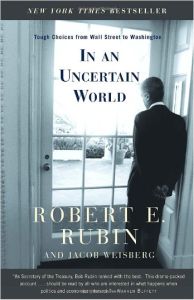Join getAbstract to access the summary!

Join getAbstract to access the summary!
Robert E. Rubin and Jacob Weisberg
In An Uncertain World
Tough Choices From Wall Street To Washington
Random House, 2003
What's inside?
Former Treasury Secretary Robert Rubin recounts his White House days: how the U.S. and global economies really work.
Recommendation
Robert Rubin, Treasury Secretary in the Clinton Administration, believes in studying probability and risk. To him, uncertainty is part of life. Therefore, his inside look at the Clinton presidency and its global financial policies is carefully considered. He admits his mistakes and recounts his efforts and his successes. He offers tremendous insight on how the U.S.’s top leaders rescued other countries from financial quagmires, and he sounds an important alarm about the disconnect between the country’s growing dependence on global trade and its public lack of support for world economic relationships. Rubin carefully walks the line between being self-serving and providing sharp insights. He doesn’t offend the Clintons, though he presents events and himself - for this has an autobiographical side, as well - with apparent candor and honesty. He hasn’t taken a lot of risks here, but that could reflect his experience. After all, Wall Street might be nearly as cutthroat as Washington. getAbstract highly recommends his book for its exploration of the Clinton presidency, its insights into fiscal policy making and its understanding that a nation’s economic fate doesn’t stop at its borders.
Summary
About the Authors
Robert Rubin rose to fame as U.S. Treasury Secretary in the Clinton Administration from 1995 to 1999. A graduate of Harvard University and Yale Law School, he joined Goldman Sachs after his first law firm job. Talented at risk arbitrage and stock option trading, he spent 26 years at the firm, eventually becoming co-chairman. In 1993, he became director of the White House National Economic Council. Rubin resides in New York City with his wife and two sons, and serves as a director and Chairman of the Executive Committee of Citicorp. Jacob Weisberg wrote In Defense Of Government, and is the editor of Slate.



















Comment on this summary